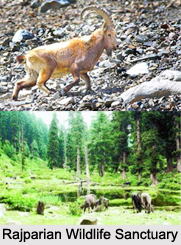 Rajparian Wildlife Sanctuary which is also Daksum Wildlife Sanctuary located in Anantnag District of Jammu and Kashmir and it is the abode of many birds and animals.
Rajparian Wildlife Sanctuary which is also Daksum Wildlife Sanctuary located in Anantnag District of Jammu and Kashmir and it is the abode of many birds and animals.
Location of Rajparian Wildlife Sanctuary
Rajparian Wildlife Sanctuary is located in Anantnag district of Jammu and Kashmir.
Geography of Rajparian Wildlife Sanctuary
Rajparian Wildlife Sanctuary is located at about 85 kilometres south of Srinagar District of Jammu and Kashmir. Rajparian Wildlife Sanctuary spreads over an area of 20 square kilometres.
Status of Rajparian Wildlife Sanctuary
Rajparian Wildlife Sanctuary was protected as a game reserve for hangul during the Maharaja"s period, prior to 1948. In 1981, it was upgraded to the Rajparian Wildlife Sanctuary. The administrative and technical control vests with the Wildlife Warden, South Kashmir Division (Bijbehara) of Wildlife Protection Department Jammu and Kashmir Government. The Wildlife Protection Department is empowered with Jammu & Kashmir Wildlife Protection Act 1978 amended up to 2002, to carry out its obligations and responsibilities.
Flora and Fauna of Rajparian Wildlife Sanctuary
The vegetation types present in the Rajparian Wildlife Sanctuary include dense coniferous forests and sub-alpine pastures. In dense coniferous forests, kail pine, spruce, fir, birch, deodar and juniper trees are predominant. Rajparian Wildlife Sanctuary is abode to many species of animals including the Himalayan black bear, hangul, and musk deer. A number of species of wild birds are also found in the sanctuary. This type of vegetation is mainly confined to the side of tributaries of the Rajparian Nala near the Daksum up to Khatan Pathri. Some principally broad leaved genera such as Aesculus indica, Juglanus regia, Rubinia, Morus, Quercus incana, Rhus succedanea, Celtis cavacasica, Prunus persica, Ulmus wallachiama, Corylus colourna, Padus cornuta etc. The shrubs dominating the ground cover include Parrotiopsis jacqumentiana, Rosa species interspersed with Viburnum, Berberies species, Rubus, Aesculus indicus, Lonicera and Indigofera species, Demodeum, Jasmine and Isodon too are existing in the area
Disturbances for Rajparian Wildlife Sanctuary
In 1970, the Government of Kashmir constructed a sheep breeding farm on 1300 hectares of prime wintering area of the now critically endangered hangul. This sheep breeding farm is believed to have had an adverse effect on the movement of hangul in this area. Besides, the sanctuary has also been disturbed due to excessive grazing by the livestock of non-local Bakarwals.
Related Articles
Indian Wildlife Sanctuaries
Culture of Jammu and Kashmir
Jammu and Kashmir, Indian State
Costumes of Jammu and Kashmir



















